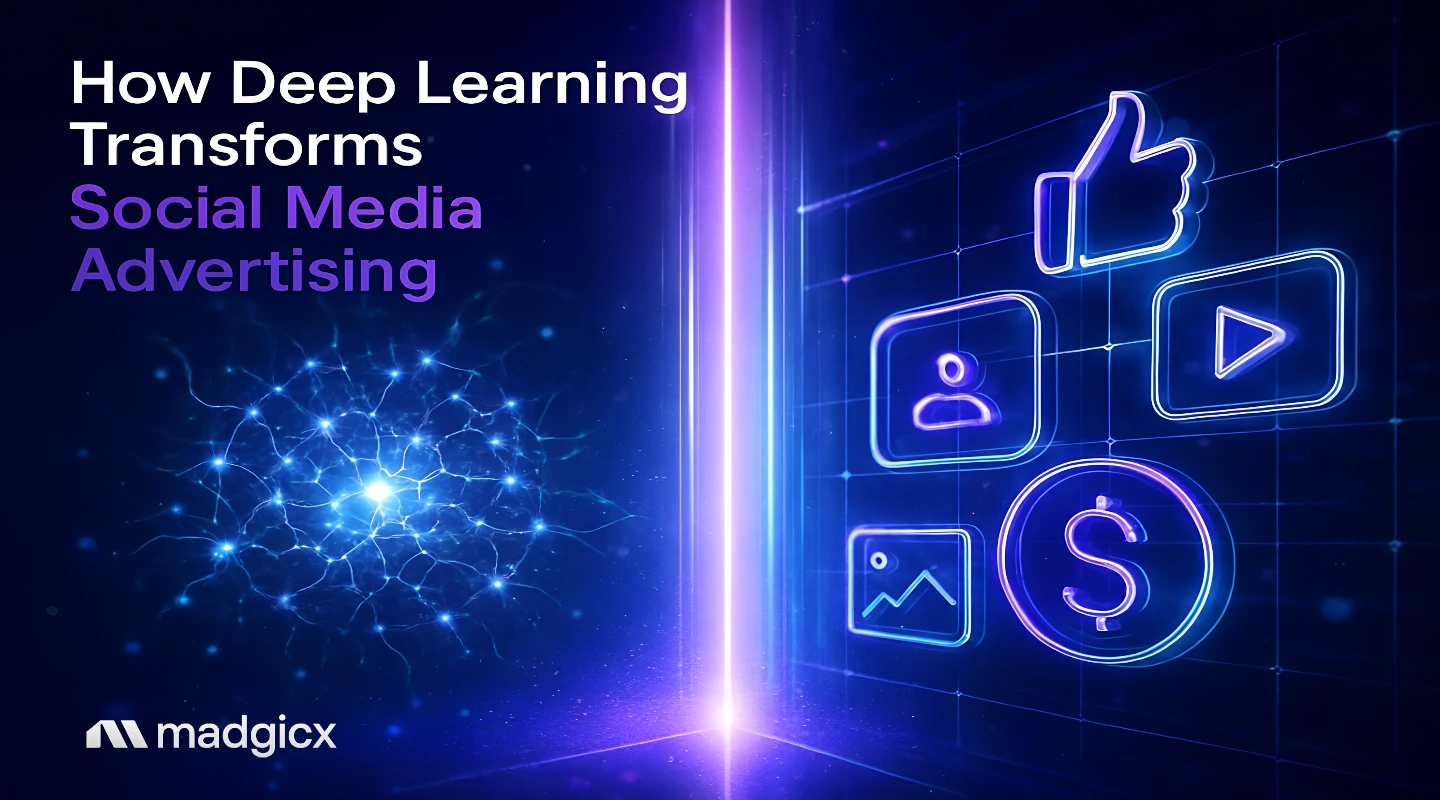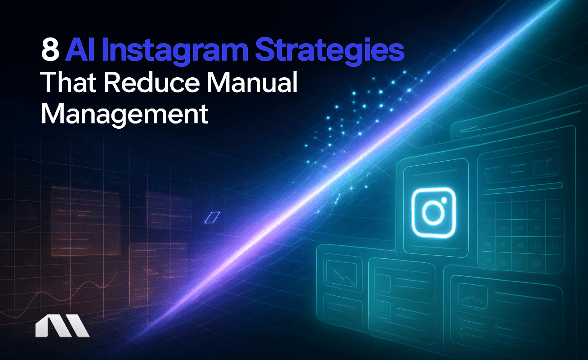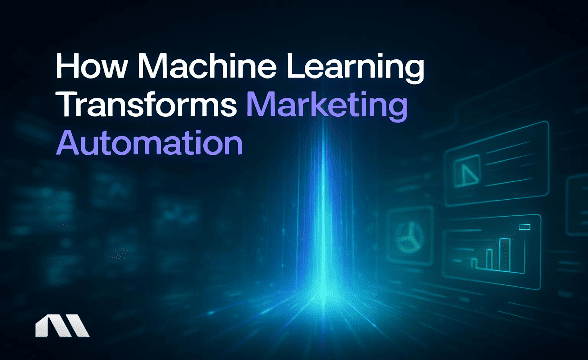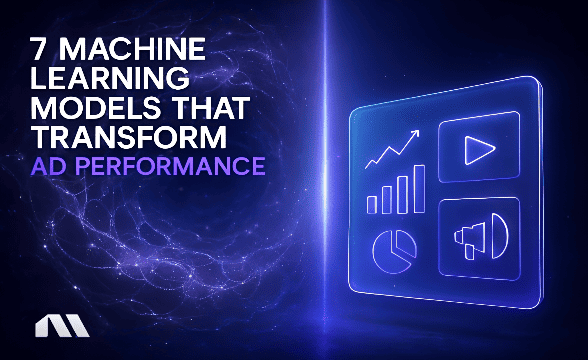Discover how deep learning transforms social media advertising with better performance. Complete implementation guide with real results and step-by-step setup.
Picture this: Your Facebook ads are performing exceptionally well for three solid weeks. You're hitting your target CPA, ROAS is climbing, and you're feeling like the advertising strategist you always knew you were.
Then Monday morning hits. Suddenly your CPA has doubled overnight while your conversion rate plummeted. Sound painfully familiar?
You're definitely not alone in this rollercoaster ride. This exact scenario happens because traditional optimization eventually hits a performance ceiling that only deep learning for social media advertising can overcome. While basic automation follows simple rules and machine learning spots patterns, deep learning actually thinks and adapts like your most experienced media buyer—except it operates continuously and processes billions of signals every single second.
Deep learning for social media advertising uses multi-layered neural networks to automatically analyze user behavior, optimize ad targeting, personalize creative content, and predict conversion likelihood in real-time. This technology achieves better performance than traditional methods by processing massive datasets to show the right ad to the right person at precisely the right moment—something that's extremely difficult to achieve manually.
In this comprehensive guide, you'll discover how deep learning works behind the scenes of your campaigns, which platforms offer the most sophisticated implementations, and step-by-step instructions to deploy these strategies for improved performance outcomes. We'll also dive into real performance data from 2024-2025 that shows just how dramatic these improvements can be.
What You'll Learn in This Guide
- How deep learning neural networks process advertising data differently than traditional AI
- Platform comparison: Meta Advantage+ vs. Madgicx vs. manual optimization performance
- Step-by-step implementation timeline with specific data requirements
- Bonus: Troubleshooting guide for common deep learning optimization issues
What is Deep Learning for Social Media Advertising?
Let's cut through the tech jargon and get to what actually matters for your campaigns. Deep learning for social media advertising is essentially like having a team of expert media buyers working around the clock, except this team can simultaneously analyze millions of user interactions, creative performance patterns, and market conditions faster than you can refresh your Ads Manager dashboard.
Here's how the evolution looks in practical terms:
- Traditional advertising: You manually set targeting, budgets, and bids based on your best guess and past experience.
- Basic AI: The platform automatically adjusts bids within parameters you set, following simple rules like "increase bid if CPA is below target."
- Machine learning: The system identifies patterns in your data and makes predictions, like recognizing that users who engage with video ads on weekends convert better.
Deep learning for social media ads: Neural networks with multiple layers process billions of signals simultaneously—user behavior, device patterns, time-based trends, creative elements, competitor activity, and market conditions—to make real-time optimization decisions that would take human analysts weeks to identify.
Think of it this way: if machine learning is like having a smart advertising assistant who notices patterns, deep learning for social media advertising is like having a genius-level strategist who understands the complex relationships between dozens of variables and can predict outcomes with remarkable accuracy.
Pro Tip: The key differentiator? Traditional automation follows rules you create. Deep learning creates its own rules based on what actually drives results, then continuously rewrites those rules as it learns more about your audience and market conditions.
How Deep Learning Works in Real-Time Social Media Advertising
Now here's where things get really interesting. While you're sleeping, deep learning algorithms are processing substantial amounts of data to optimize your social media campaigns. We're talking about analyzing billions of signals per second—user scroll speed, time spent viewing content, previous purchase behavior, device usage patterns, and hundreds of other micro-signals that human brains simply can't process simultaneously.
The optimization occurs in what's called the "learning phase," but unlike the basic learning phase you see in Facebook Ads Manager, deep learning for social media advertising operates on multiple levels simultaneously. The first layer might analyze basic demographic and behavioral data, while deeper layers identify complex patterns like "users who engage with carousel ads featuring lifestyle imagery on mobile devices between 7-9 PM on weekdays are 340% more likely to convert within 24 hours."
Here's what's happening behind the scenes during real-time bidding:
Millisecond 1: User opens Instagram, deep learning instantly analyzes their profile, recent activity, and current context.
Millisecond 2: The algorithm predicts conversion likelihood based on thousands of similar user patterns and current campaign performance.
Millisecond 3: It determines optimal bid amount, creative variation, and placement based on real-time competition and performance data.
Millisecond 4: Your ad appears (or doesn't) based on this rapid analysis.
This entire process repeats millions of times per day across your campaigns, with each interaction feeding back into the neural network to improve future decisions. It's like having a media buyer who learns from every single impression and gets smarter with each passing second.
The optimization cycles run continuously, not just during Facebook's traditional learning phases. While basic automation might check performance once per hour and make simple adjustments, deep learning systems are constantly fine-tuning targeting, creative selection, and bid strategies based on real-time performance signals.
Platform Deep Learning Comparison: What Actually Works
Let's get real about what each platform offers and when you should use what. The landscape has changed dramatically in 2024-2025, and understanding these differences can significantly impact your campaign performance.
Meta Advantage+ (Facebook/Instagram Native)
Meta's Advantage+ campaigns represent their most sophisticated deep learning implementation. According to Meta's 2024 performance data, Advantage+ delivers an average of 4% higher click-through rates and 3.8% conversion lift compared to manual campaigns. The system automatically optimizes across 150+ targeting signals and can expand audiences far beyond your initial parameters.
The sweet spot? E-commerce businesses with at least 50 weekly conversions and diverse product catalogs. Advantage+ excels at finding new customers who look nothing like your existing audience but convert just as well.
Madgicx AI Marketer (Third-Party Advanced Automation)
While Meta handles the basic optimization, Madgicx's AI Marketer adds a crucial layer of campaign management automation that Meta doesn't provide. It performs daily account audits, identifies scaling opportunities, and provides one-click optimization recommendations based on deep learning analysis of your account performance patterns.
The key advantage? Madgicx works across your entire account structure, not just individual campaigns. It can identify when to pause underperforming ad sets, when to increase budgets on winners, and how to structure your campaigns for optimal deep learning performance. This level of account-wide automation is something you simply can't get from platform native tools alone.
Google Smart Bidding
Google's approach focuses heavily on search intent signals and conversion prediction. Their deep learning models excel at understanding user intent based on search queries and browsing behavior. Performance improvements typically range from 10-20% for conversion-focused campaigns, but the real strength lies in cross-platform attribution and audience insights.
TikTok's Algorithm
TikTok's deep learning is primarily content-focused, analyzing video engagement patterns, audio preferences, and viral potential. While less sophisticated for traditional conversion optimization, it's unmatched for brand awareness and engagement campaigns targeting younger demographics.
When to Use Each Platform:
- Meta Advantage+: E-commerce conversion campaigns with sufficient data
- Madgicx + Meta: Complex account structures requiring advanced automation
- Google Smart Bidding: Search-driven campaigns with clear intent signals
- TikTok: Brand awareness and engagement for Gen Z/Millennial audiences
Pro Tip: The most successful performance marketers aren't choosing one platform—they're strategically combining these tools based on campaign objectives and audience characteristics.
Core Deep Learning Applications That Actually Move the Needle
Let's dive into the specific ways deep learning for social media advertising transforms your performance. These aren't theoretical benefits—these are practical applications you can implement today to see measurable improvements in your campaigns.
Audience Targeting and Expansion
Traditional lookalike audiences are based on surface-level similarities—demographics, interests, and basic behaviors. Deep learning audience expansion goes several layers deeper, identifying users who share complex behavioral patterns with your converters, even if they look completely different on paper.
For example, machine learning models using engagement metrics can identify that users who scroll quickly through feeds but pause on video content with specific visual elements convert 280% better than users who match your demographic targeting but have different engagement patterns.
The practical result? Your audience sizes can expand 3-5x while maintaining or improving conversion rates. RTB House reported a 41% increase in click-through rates when implementing deep learning audience optimization compared to traditional targeting methods.
Creative Optimization and Testing
Instead of running basic A/B tests, deep learning systems can analyze thousands of creative elements simultaneously—colors, text placement, imagery style, call-to-action wording, and even subtle design elements you'd never think to test manually.
MediaGo's case study showed 35% ROAS improvement, 15% CTR increase, and 40% conversion rate boost when implementing deep learning creative optimization. The system identified that specific color combinations performed 67% better for their target audience, but only when combined with certain headline structures—insights that would take months of manual testing to discover.
Bid Strategy Automation
Deep learning bid optimization goes beyond simple CPA or ROAS targets. The algorithms analyze real-time auction dynamics, competitor behavior, and user likelihood to convert at different price points. This means your bids automatically adjust not just based on your performance, but based on market conditions and competitive landscape changes.
Fraud Detection and Traffic Quality
One of the most underappreciated benefits of deep learning for social media advertising is its ability to identify and filter out low-quality traffic in real-time. The algorithms can detect subtle patterns that indicate bot traffic, click farms, or users unlikely to convert, protecting your budget from waste before it happens.
Predictive Analytics and Forecasting
Advanced machine learning models for campaign optimization can predict campaign performance trends 7-14 days in advance, allowing you to adjust budgets and strategies before performance declines become visible in your standard reporting.
This predictive capability is particularly powerful for seasonal businesses or product launches, where traditional optimization methods react to changes rather than anticipating them.
Implementation Guide: Your Step-by-Step Deep Learning Setup
Ready to implement deep learning for social media advertising? Here's your practical roadmap with specific requirements and realistic timelines. Skip any of these steps, and you'll likely see disappointing results—but follow this process, and you'll be positioned for the 15-41% performance improvements we've been discussing.
Phase 1: Data Foundation (Week 1-2)
Before any deep learning system can work effectively, you need sufficient, high-quality data. The recommended threshold is at least 50 weekly conversions for meaningful optimization. If you're below this threshold, focus on increasing conversion volume through broader targeting or lower-funnel conversion events before implementing deep learning strategies.
Set up proper tracking infrastructure:
- Facebook Pixel with all standard events configured
- Conversions API (CAPI) implementation for iOS-resistant tracking
- Google Analytics 4 with enhanced e-commerce tracking
- UTM parameter consistency across all campaigns
Phase 2: Creative Asset Preparation (Week 2-3)
Deep learning creative optimization requires variety to identify winning patterns. Prepare 10-50 creative variations across different formats:
- Static images with varying visual styles, colors, and layouts
- Video content with different hooks, lengths, and calls-to-action
- Carousel ads showcasing different product combinations
- User-generated content and testimonials
The key is systematic variation—change one element at a time so the algorithm can identify which specific components drive performance improvements.
Phase 3: Campaign Structure Setup (Week 3-4)
Structure your campaigns to maximize deep learning effectiveness:
- Use broad targeting initially (let the algorithm find your audience)
- Set up conversion-focused objectives with sufficient budget
- Implement automatic placements across all available inventory
- Configure dynamic creative testing with your prepared assets
Budget allocation strategy: Start with 150-200% of your typical daily budget to accelerate the learning phase. Deep learning systems need volume to identify patterns quickly.
Phase 4: Advanced Automation Implementation (Week 4+)
This is where tools like Madgicx's AI Marketer become crucial. While platform native tools handle basic optimization, you need advanced Meta ads automation to manage campaign structures, budget allocation, and scaling decisions based on deep learning insights.
Set up automated rules for:
- Budget increases on high-performing ad sets
- Pause triggers for underperforming campaigns
- Audience expansion based on conversion patterns
- Creative rotation based on performance trends
Timeline Expectations:
- Week 1-2: Data collection and initial learning
- Week 3-4: Pattern identification and optimization begins
- Week 5-8: Significant performance improvements become visible
- Week 8+: Sustained optimization and scaling opportunities
Pro Tip: The most common mistake? Making manual changes during the first 4 weeks. Deep learning systems need time to identify complex patterns—premature optimization often resets the learning process and delays results.
Performance Results: What Deep Learning Actually Delivers
Let's talk real numbers from real campaigns. The deep learning advertising market is expanding rapidly for a reason—it's delivering measurable results that traditional optimization simply can't match. The market is projected to grow from $34.28 billion in 2025 to $279.6 billion by 2032, representing a 35% compound annual growth rate.
But market projections don't pay your bills—campaign performance does. Here's what leading advertisers are actually achieving with deep learning for social media advertising implementation:
RTB House Case Study: 41% Performance Boost
RTB House implemented deep learning personalization across their display advertising campaigns and saw a 41% increase in click-through rates compared to their previous machine learning approach. The key breakthrough? Their deep learning system identified micro-behavioral patterns that traditional targeting missed entirely.
The algorithm discovered that users who viewed product pages for 15-30 seconds but didn't scroll were 340% more likely to convert when shown carousel ads featuring lifestyle imagery, while users who scrolled quickly through product details responded better to single-image ads with clear pricing information.
MediaGo's Comprehensive Results
MediaGo's implementation of deep learning optimization delivered across multiple metrics: 35% ROAS improvement, 15% CTR increase, and 40% conversion rate boost. What made their approach successful was systematic testing across creative elements, audience segments, and bidding strategies simultaneously.
Their deep learning system identified that specific color combinations (blues and greens) performed 67% better for their target audience, but only when combined with urgency-based headlines and mobile-optimized layouts. These multi-variable insights would have taken 6+ months to discover through traditional A/B testing.
Meta Advantage+ Platform Performance
Meta's own data shows that Advantage+ campaigns deliver 4% higher click-through rates and 3.8% conversion lift compared to manual campaign management. While these improvements might seem modest, they compound significantly over time and across large advertising budgets.
The real advantage of Advantage+ isn't just the performance improvement—it's the time savings. Advertisers report spending 60-70% less time on manual optimization tasks while achieving better results.
Industry-Wide AI Marketing ROI
According to recent research, 47% of companies report their AI marketing projects are profitable, with most seeing 10-20% ROI improvements within the first six months of implementation. The key differentiator between successful and unsuccessful implementations? Data quality and sufficient conversion volume for meaningful optimization.
Madgicx Client Success Stories
Our AI Marketer has helped clients achieve similar results through advanced automation that works alongside platform native tools. One e-commerce client saw 43% reduction in cost per acquisition while scaling ad spend 280% over six months. The secret? Automated budget allocation based on deep learning performance predictions, combined with real-time creative optimization.
These results represent what's possible when deep learning for social media advertising is implemented strategically rather than as a "set it and forget it" solution, with proper implementation, sufficient data, and realistic expectations.
Optimization and Troubleshooting: Making Deep Learning Work
Even the most sophisticated deep learning systems need proper management to deliver optimal results. Here's your week-by-week guide to monitoring, optimizing, and troubleshooting your deep learning campaigns for sustained success.
Week 1-2: The Foundation Phase
During the initial learning period, resist the urge to make changes. Deep learning algorithms are analyzing thousands of variables simultaneously, and premature optimization can reset the learning process. However, you should monitor these key indicators:
- Delivery Status: Ensure campaigns are spending budget consistently
- Data Quality: Verify tracking is recording conversions accurately
- Audience Size: Confirm your targeting isn't too narrow (minimum 1M potential reach)
- Creative Performance: Check that all creative variations are getting impressions
Common issues and solutions:
- Low delivery: Increase budget or broaden targeting
- No conversions recorded: Check pixel implementation and conversion events
- Uneven creative distribution: Reduce number of active creatives to 3-5 per ad set
Week 3-4: Pattern Recognition Begins
This is when deep learning systems start identifying meaningful patterns. You'll begin seeing performance variations between audiences, creatives, and placements. Key metrics to watch:
- Cost per result trends: Should begin stabilizing or improving
- Audience insights: New demographic or interest patterns emerging
- Creative performance: Clear winners and losers becoming apparent
- Placement optimization: Automatic shifts toward best-performing placements
Warning signs that require intervention:
- Consistently increasing CPA: May indicate targeting is too broad or creative fatigue
- Declining conversion rates: Could signal audience saturation or competitive pressure
- Uneven budget distribution: Some ad sets getting 80%+ of budget while others get none
Week 5-8: Optimization and Scaling
Performance improvements should be clearly visible by week 5. This is when you can begin making strategic optimizations based on deep learning insights:
Scaling Successful Patterns:
- Increase budgets on consistently high-performing ad sets (20-50% increases)
- Create new campaigns using winning audience and creative combinations
- Expand targeting based on successful audience insights
- Test new creative variations that follow winning patterns
Advanced Troubleshooting
Problem: Performance plateaued after initial improvements
Solution: Introduce new creative variations or expand audience targeting. Deep learning systems need fresh data to continue optimizing.
Problem: High-performing campaigns suddenly declined
Solution: Check for ad fatigue detection using machine learning algorithms. Refresh creative assets or pause overexposed ads.
Problem: Inconsistent day-to-day performance
Solution: This is normal for deep learning optimization. Focus on 7-day rolling averages rather than daily fluctuations.
When to Make Changes vs. Let Algorithm Learn
The golden rule: If performance is trending in the right direction over 7-14 days, don't interfere. Deep learning systems often show temporary dips while exploring new optimization opportunities.
Make changes when:
- Performance has declined consistently for 10+ days
- Conversion volume has dropped below minimum thresholds (50 weekly conversions)
- External factors have changed (new product launch, seasonal shifts, competitive landscape)
Pro Tip: Once you've identified winning deep learning patterns, scaling requires a systematic approach: horizontal scaling (new campaigns), vertical scaling (budget increases), creative scaling (new variations), and platform scaling (expanding to additional channels).
Frequently Asked Questions
How much data does deep learning for social media advertising need to work effectively?
Deep learning advertising systems typically require a minimum of 50 weekly conversions to identify meaningful patterns and optimize effectively. Below this threshold, the algorithms don't have sufficient signal to distinguish between random variation and actual performance trends. For optimal results, aim for 100+ weekly conversions, which allows the system to test multiple variables simultaneously while maintaining statistical significance.
If you're below the minimum threshold, consider optimizing for higher-funnel events (like add-to-cart or email signups) initially, then transition to purchase optimization once you've built sufficient conversion volume.
How long until I see results from deep learning optimization?
Most deep learning systems show initial improvements within 2-3 weeks, with significant performance gains becoming apparent by week 5-8. However, the timeline depends heavily on your conversion volume and data quality. Accounts with higher conversion volumes (200+ weekly conversions) often see improvements faster than those operating at minimum thresholds.
The learning process is continuous—deep learning systems continue improving performance for months as they identify increasingly sophisticated patterns in your data. Many advertisers report their best performance occurs 3-6 months after initial implementation.
Should I use platform native tools or third-party AI solutions?
The most effective approach combines both. Platform native tools like Meta Advantage+ and Google Smart Bidding excel at auction-level optimization and have access to the most comprehensive user data. However, they don't provide account-level automation or cross-campaign optimization.
Third-party solutions like Madgicx's AI Marketer add crucial layers of campaign management automation, budget allocation optimization, and performance monitoring that platform tools don't offer. The combination provides both micro-level (individual auction) and macro-level (account structure) optimization.
What's the difference between machine learning and deep learning for ads?
Machine learning for advertising typically uses simpler algorithms to identify patterns and make predictions based on historical data. It's excellent for tasks like basic audience targeting and bid optimization within defined parameters.
Deep learning for social media advertising uses neural networks with multiple layers to identify complex, non-linear relationships between variables. It can discover patterns that traditional machine learning misses, like the interaction between creative elements, audience characteristics, and timing factors. Advanced machine learning models in advertising tech provide more detailed comparisons of these approaches.
How do I know if deep learning is actually improving my performance?
Track these key performance indicators over 30-60 day periods:
- Cost per acquisition trends: Should show consistent improvement or stabilization
- Conversion rate improvements: Particularly important for e-commerce campaigns
- Audience expansion success: Ability to maintain performance while reaching new users
- Time savings: Reduced manual optimization requirements
- Scaling capability: Ability to increase spend while maintaining efficiency
Compare performance to pre-implementation baselines rather than day-to-day fluctuations. Deep learning optimization often shows temporary performance dips while exploring new opportunities, so focus on longer-term trends rather than daily variations.
Start Your Deep Learning Journey Today
The advertising landscape is evolving at breakneck speed, and deep learning for social media advertising isn't just a competitive advantage anymore—it's becoming essential for serious performance marketers. The data we've covered today shows consistent 15-41% performance improvements across different platforms, industries, and campaign types.
But here's the thing: these results don't happen automatically. They require proper implementation, sufficient data, realistic expectations, and ongoing optimization based on deep learning insights. The advertisers who master these systems today will have significant advantages in tomorrow's increasingly competitive market.
Your next steps are straightforward:
- Audit your current data foundation and ensure you have the minimum 50 weekly conversions needed for effective deep learning optimization
- Choose your platform strategy based on your campaign objectives and technical requirements
- Implement systematic testing across creative variations, audience segments, and bidding strategies
- Set up advanced automation to manage the complex optimization decisions that deep learning systems require
The deep learning revolution in advertising is happening right now. Companies implementing machine learning in e-commerce marketing are already seeing dramatic improvements in their advertising performance through strategic implementation of these technologies.
For performance marketers ready to take their campaigns to the next level, Madgicx's AI Marketer provides the advanced automation layer that transforms deep learning insights into actionable optimizations. While platform native tools handle the basic optimization, our AI system manages the complex campaign structures, budget allocation decisions, and scaling strategies that maximize deep learning performance.
The question isn't whether deep learning will transform advertising—it already has. The question is whether you'll be leading this transformation or working to catch up. The choice, and the competitive advantage, is yours.
Stop guessing which campaigns will be profitable. Madgicx's AI Marketer uses advanced machine learning to help predict ROAS in real-time, continuously optimizing your Meta ads with AI assistance. Join thousands of performance marketers already scaling with AI-powered predictions.
Digital copywriter with a passion for sculpting words that resonate in a digital age.







.avif)







